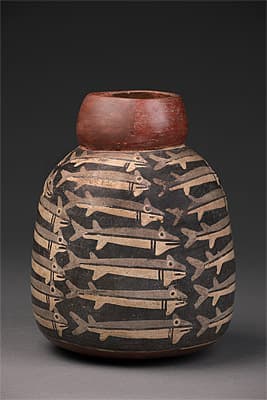
NAZCA culture South coast 100 – 700 AD
Vessel depicting fish 100-700 AD ceramic22.2 (h) cm 17.5 cm (diameter) Ministerio de Cultura del Perú: Museo Nacional de Arqueología, Antropología e Historia del Perú, Photograph: Daniel Giannoni
The artist who painted a school of anchovies swimming together around the vessel conveys the abundance of the seas off the southern coast of Peru. The jar would have been filled with offerings, showing ‘the propitiatory role of pieces such as this vessel, which perhaps sought to ensure good fishing or to appease the over-watching gods’.1 It is notable for its combination of excellent design and placement of the fish, intense observation of nature—we can easily identify which type of fish is portrayed—and symbolic meaning.
The bulbous shape of the jar and its neck reveal how they were built up with coils of clay; the pot was then decorated using slips of reddish brown, blue, grey and white, and finally fired.
For kilns, ancient Peruvians used:
simple shallow earthen pits … The unfired objects were placed in the pit, then surrounded and covered with fuel. Wood was the most common fuel, but animal dung and the compacted leaves that accumulate beneath trees may also have been used.2
Christine Dixon
1. Johny Isla, ‘The Nazca culture’, in Peru: Art from the Chavín to the Incas, Paris: Paris-musées, Milan: Skira 2006, p. 69.
2. Christopher B. Donnan, Ceramics of ancient Peru, Los Angeles: Fowler Museum of Cultural History, UCLA 1992, p. 20.
The artist who painted a school of anchovies swimming together around the vessel conveys the abundance of the seas off the southern coast of Peru. The jar would have been filled with offerings, showing ‘the propitiatory role of pieces such as this vessel, which perhaps sought to ensure good fishing or to appease the over-watching gods’.1 It is notable for its combination of excellent design and placement of the fish, intense observation of nature—we can easily identify which type of fish is portrayed—and symbolic meaning.
The bulbous shape of the jar and its neck reveal how they were built up with coils of clay; the pot was then decorated using slips of reddish brown, blue, grey and white, and finally fired.
For kilns, ancient Peruvians used:
simple shallow earthen pits … The unfired objects were placed in the pit, then surrounded and covered with fuel. Wood was the most common fuel, but animal dung and the compacted leaves that accumulate beneath trees may also have been used.2
Christine Dixon
1. Johny Isla, ‘The Nazca culture’, in Peru: Art from the Chavín to the Incas, Paris: Paris-musées, Milan: Skira 2006, p. 69.
2. Christopher B. Donnan, Ceramics of ancient Peru, Los Angeles: Fowler Museum of Cultural History, UCLA 1992, p. 20.
The artist who painted a school of anchovies swimming together around the vessel conveys the abundance of the seas off the southern coast of Peru. The jar would have been filled with offerings, showing ‘the propitiatory role of pieces such as this vessel, which perhaps sought to ensure good fishing or to appease the over-watching gods’.1 It is notable for its combination of excellent design and placement of the fish, intense observation of nature—we can easily identify which type of fish is portrayed—and symbolic meaning.
The bulbous shape of the jar and its neck reveal how they were built up with coils of clay; the pot was then decorated using slips of reddish brown, blue, grey and white, and finally fired.
For kilns, ancient Peruvians used:
simple shallow earthen pits … The unfired objects were placed in the pit, then surrounded and covered with fuel. Wood was the most common fuel, but animal dung and the compacted leaves that accumulate beneath trees may also have been used.2
Christine Dixon
1. Johny Isla, ‘The Nazca culture’, in Peru: Art from the Chavín to the Incas, Paris: Paris-musées, Milan: Skira 2006, p. 69.
2. Christopher B. Donnan, Ceramics of ancient Peru, Los Angeles: Fowler Museum of Cultural History, UCLA 1992, p. 20.

